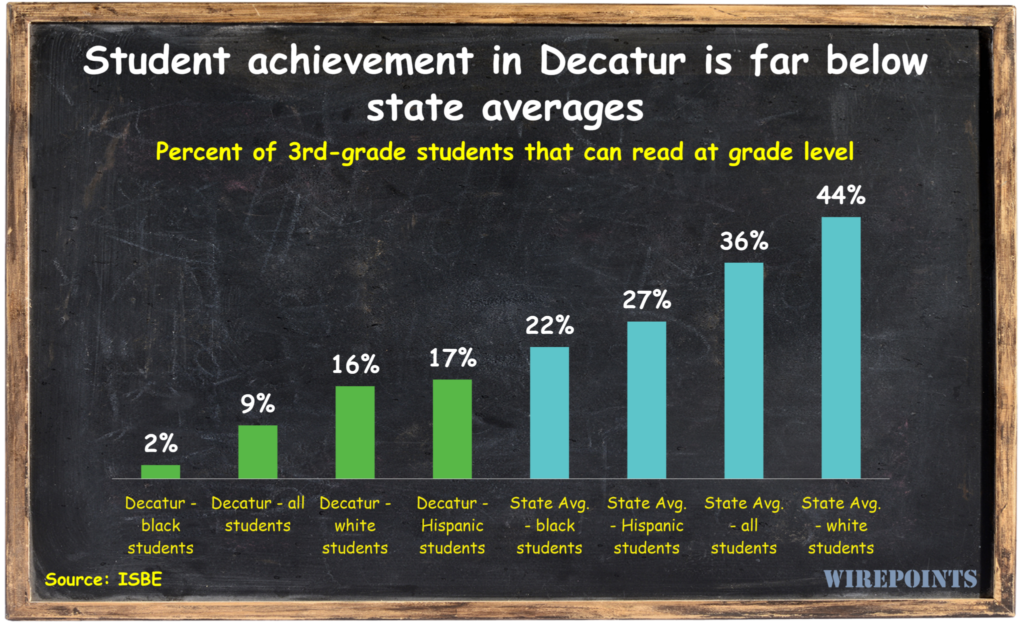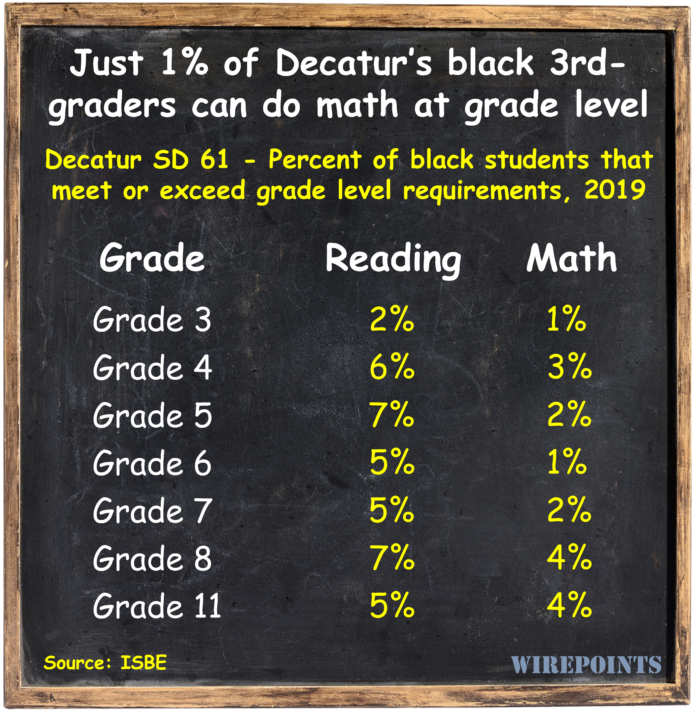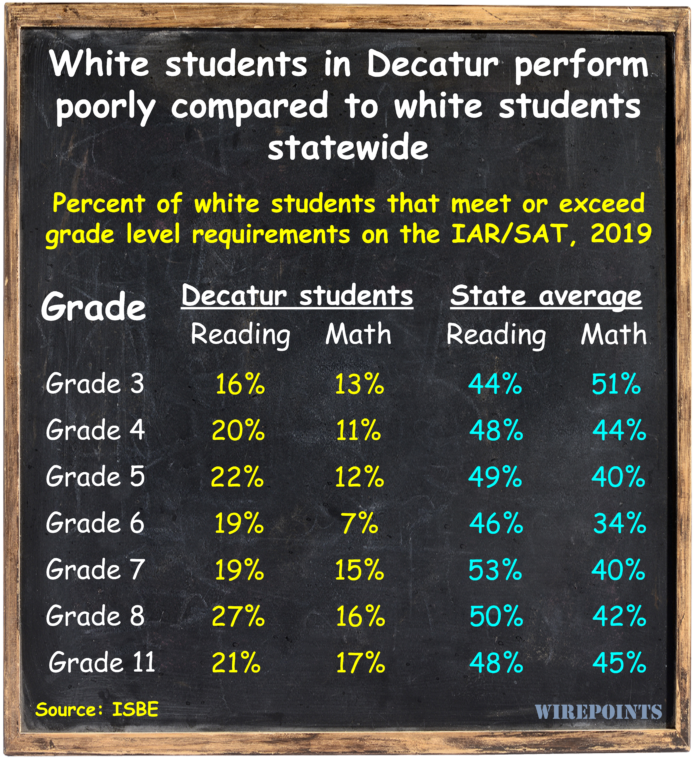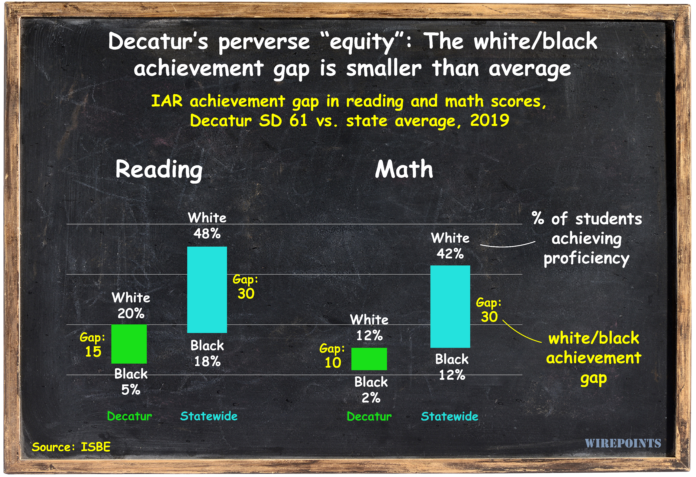The Wall Street Journal recently posted a scathing indictment of K-12 education in Illinois, drawing on research by conservative Illinois thinktank Wirepoints. The article and research show a perverse form of “equity” in Illinois schools: across the racial spectrum, nobody can read.
Below is part I of Wirepoint’s report, slightly abbreviated. It does not make happy reading.
An indictment of Illinois’ education system
If what follows isn’t an indictment of Illinois’ education establishment, we don’t know what is. Of Decatur’s public school 3rd-graders in 2019, just 2 percent of black and 16 percent of white students could read at grade level. In Rockford, it was 7 percent of black students. In Peoria, 8 percent of blacks. And in Elgin, just 11 percent of Hispanic 3rd-graders could read at grade level. Similar results can be found across the state.
The data Wirepoints presents in this report represents an absolute dereliction of duty by those who run Illinois’ public schools. It’s not about money, it’s not about race, it’s not about curriculum and it’s not about critical race theory. It’s about a system that fails at its most basic function: to prepare Illinois children for their future.
Our assessment is harsh because student outcomes are beyond dismal and no one, it seems, takes any responsibility for them. Social promotion, hyper-inflated teacher evaluations and misleading “accountability” designations from the Illinois State Board of Education all help to deflect blame.
Wirepoints uses the phrase “cannot read or do math at grade level” to describe students who do not meet Illinois Assessment of Readiness (IAR) “proficiency” standards. This is consistent with the Illinois School Board of Education’s definition of proficient: “Students performing at levels 4 and 5 met or exceeded expectations, have demonstrated readiness for the next grade level/course and, ultimately, are likely on track for college and careers. ”We also use the “grade level” definition as shorthand for the 11th-grade Scholastic Aptitude Test (SAT) proficiency standards.
We’re also harsh because nobody in the system wants to upset the apple cart. The rewards are just too lucrative. The Illinois Constitution and multi-year labor contracts guarantee job security, big salaries and even bigger pensions for those in education. The sprawling district bureaucracy provides thousands of administrative jobs. Not to mention the back-scratching relationship between unions and lawmakers that protects the status quo.
This report focuses on Decatur School District 61 because it’s arguably the poster child for the education system’s failures. Just 9 percent of Decatur’s 3rd-grade students can read at grade level. And every year the district graduates hundreds of students who are grossly unprepared for either college or a career.

The same story could be written about the students of Rockford, Waukegan, Peoria, Quincy, Chicago or any one of a hundred Illinois cities. The only difference is in the degree of failure.
For sure, plenty of Illinois’ 860 school districts achieved better student outcomes in 2019. But a cursory glance at state report card data shows higher performers were the minority. Just 89 districts had at least 60 percent of students who could read at grade level. In 168 districts, by comparison, less than 25 percent of students could read at grade level.
Overall, less than 40 percent of all students in Illinois were proficient in either reading or math (see Appendix for details).
Who is it that’s allowing such bad outcomes to persist without intervention? Administrators? School boards? The Illinois State Board of Education? State lawmakers? And where are the parents in all this? Does anybody care?
Below we look at Decatur’s failed results and how parents are misled by district and state statistics. We also highlight the poor results of other major districts across the state. Last, we examine the “underfunding” myth and how Illinois’ education system perpetuates itself despite its failures. It’s important to note that Wirepoints focused on 2019 achievement data to avoid the noise the pandemic had on student outcomes in 2020 and 2021. School closures, remote learning, masks and more have had a significant negative impact on outcomes that will take years to unpack.
The failures of Decatur SD 61
When Wirepoints first came across the pre-pandemic 3rd-grade reading scores of Decatur Public Schools last year, we thought they’d been misreported. The State Board of Education’s Report Card said just 2 percent of Decatur’s black 3rd-graders met or exceeded reading requirements in 2019. Just 2 percent?

When we clicked over to the math results, they were worse. Only 1 percent of Decatur’s black 3rd-graders could do math at grade level. We didn’t believe the results could be so dire, but the bad numbers persisted all the way through high school, where only 5 percent of black 11th-graders met reading standards.
About 8,400 kids go to Decatur Public Schools and half of them are black, so if there’s no change in the next decade more than 3,000 black students will enter the workforce ill-prepared – or worse. And before anyone lays the blame on “white supremacy” and “systemic racism,” know that it’s not much better for Decatur’s white kids, who make up more than a third of the district’s enrollment.

Just 16 percent of white 3rd-graders were reading at grade level in 2019. That outcome is far lower than the 44 percent statewide average for whites.
The white scores in Decatur are so low that the district has achieved a perverse form of “equity:” all students, regardless of color, are failing.
The district’s black/white reading achievement gap is only 15 percentage points, half the statewide gap of 30 percentage points. Decatur’s achievement gap for math is even smaller: 10 percentage points versus 30 statewide. Normally, a narrow gap would be cause for celebration. Not so here.
Excuses

Wirepoints went down to Decatur in November 2021 to hear what district officials had to say about their student results. There we met with Jeff Dase, Assistant Superintendent for Teaching and Learning, the district’s new accountability manager, and Denise Swarthout, Chief Communications Officer.
The discussion at first focused on the pandemic and how difficult things had become over the past months. Certainly Decatur, with its large low-income population, was struggling. But Wirepoints’ primary interest lay in understanding why the district’s pre-COVID outcomes were so bad.
Yes, they verified, Decatur’s reading and math numbers were “alarmingly low.”
Many of the district’s problems, we were told, were due to a lack of an established district-wide curriculum in previous years. Individual teachers managed their own lesson plans.
High turnover in the district’s administration was also to blame. Every new administrator instituted their own processes and plans, so no initiative was ever maintained for long.
More skilled teachers are needed, they said. More black teachers, too. Students need more robust incentives. And, of course, the district said it needs more money for higher salaries and more programs.
However, even if all of that were true, it can’t explain why only 2 percent of black students could do math at grade level.
Coming tomorrow in Part II –
It’s all a facade
In a system with this much failure it’s easy to fault everyone involved with the city’s education system, including Decatur’s parents. But before we assign parents their share of the blame, let’s first look at what the education system is selling to the public.








